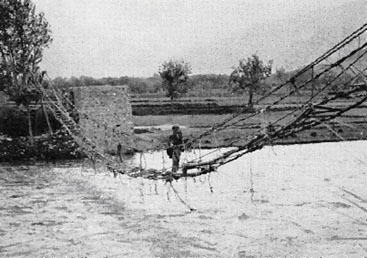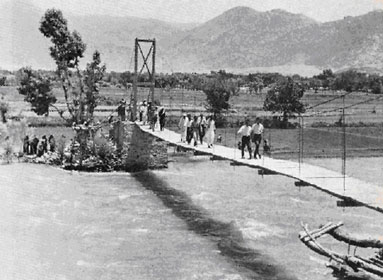The Corps Designed Suspension Bridges that Saved Lives in Afghanistan
 |
Old "Cricket Bridge" with the Corps-built abutment
for the new bridge on the far shore. |
 |
| Afghani villagers line up to cross the newly-completed "Cricket Bridge" |
At the request of the provincial governor of Laghman province in Afghanistan, during the 1960s the U.S. Agency for International Development (USAID) sought the assistance of the U.S. Army Corps of Engineers in overcoming a hazardous situation. While making their way to market or school, many Afghan villagers risked falling to their deaths while attempting to cross flooded rivers on antiquated and unstable bridges. Engineers from the area office of the Gulf District, Mediterranean Division designed a new type of bridge to solve the problem. Also, in an effort to allow for future construction, they ensured all building materials except for the cables and connectors were locally obtainable.
The design of the bridge was simple and easily replicated. Twenty-foot tall towers made of local timbers were set on masonry abutments into which steel cables were cemented. At the top of the towers were rollers that reduced friction and held up the cables. The nonrigid deck system consisted of beams attached to main cables with planks set on top of attached stringers. This system was supported by a series of steel hangers attached to the main cables. The maximum load was 1,000 pounds per 3-meter section, based on the approximate weight of a loaded donkey, with the clear width of the bridge being 2.8 meters. Engineers designed two variations of this bridge -- one strictly for pedestrian and animal crossings and another that also would allow for vehicles.
he first of these suspension bridges was built for less than $1,000, split between USAID and the local township. Its construction by indigenous laborers was supervised by a Peace Corps volunteer and managed throughout by periodic visits from Engineers. The timing of its emplacement was fortuitous. An old man nicknamed "the Cricket" had been maintaining a decrepit older bridge in a nearby spot for as long as anyone could remember. Prior to the new bridge’s completion, "the Cricket" fell into the tributary over which his bridge crossed while attempting to repair it and drowned. His untimely death was soon followed by the equally unexpected washing out of the old bridge during a flood. In honor of the elderly man’s service, the Corps-designed structure soon acquired "the Bridge of the Cricket" as its moniker.
Subsequently, two additional suspension bridges of the same design were constructed in the province. The success of these bridges, essentially self-help programs, were an early tribute to the Corps' efforts to improve the everyday lives of the Afghan people.
 |
| American and Afghani officials opening the new bridge |
* * *
December 2001